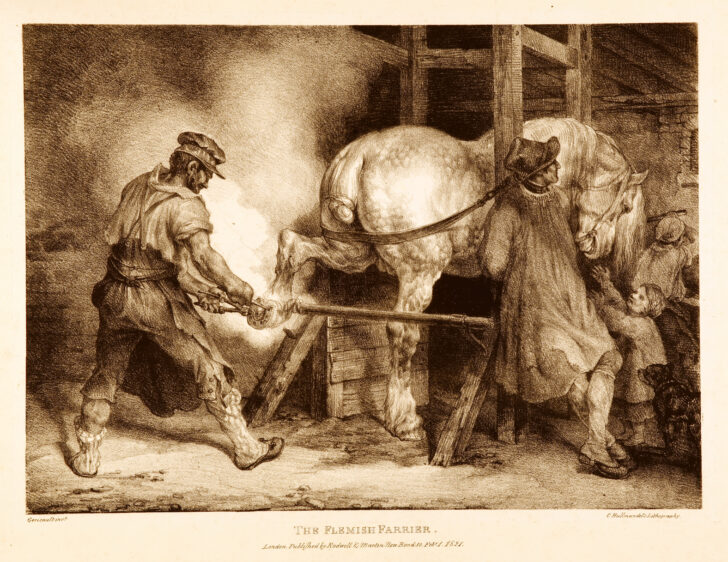The Flemish Farrier
Théodore Géricault

Description
Gallery Rotation Fall 2011
Théodore Géricault
France, 1791–1824
The Flemish Farrier
1821
Lithograph
Gift of Ruth W. and Clarence J. Boldt, Jr., 2008/2.274
The Flemish Farrier conveys the close quarters and dark working conditions of a blacksmith’s shop in which a horse is restrained while being fitted for shoes. Both the horse and the smith have tensed muscles and the subject recalls Géricault’s earlier exploration of the relationship between man and horse in the Barberi horse race in Rome (a graphite study for which is on view in one of the drawers in this cabinet). In those works, the arcs of arms and necks and their related forces have a geometric purity; here the greater realism is used to show man and beast not straining against one another so much as sharing the same tense musculature. This lithograph is a particularly luminous image; the steam and smoke and the delicate gradations in values evoke a rich and palpable atmosphere.
Following his 1820 visit to England, Géricault executed a number of lithographs showing horses being shod and coal carts with their robust draft horses. A talented painter of horses, Géricault’s equine works received fresh stimulus from the English artist David Wilkie’s (1785–1841) genre and hunting scenes and James Ward’s (1769–1859) heroic paintings of horses.
Subject Matter:
A talented painter of horses, Géricault’s equine works received fresh stimulus from the work of English artists such as David Wilkie’s genre and hunting scenes and James Ward’s heroic paintings of horses. Following his 1820 visit to England, Géricault executed a number of lithographs showing horses being shoed and coal carts with their robust draft horses.
The Flemish Farrier conveys the close quarters and dark working conditions of a blacksmith’s shop as the horse is restrained while being fitted for shoes. Both the horse and the smith have tensed muscles and the subject recalls Géricault’s earlier exploration of the relationship between man and horse in the Barberi riderless horse race in Rome (see double-sided drawing 1984/1.286). In those earlier works, the arcs of arms and necks and their related forces take on a geometric purity; here the greater realism of this farrier at work shows the two not straining against one another as much as sharing the same tense musculature. This print is a particularly luminous image; the steam and smoke and the delicate gradations in values in this lithograph evoke a rich palpable atmosphere.
Physical Description:
Paper size: h 33 3/5cm x tw 42 1/2cm & bw 42 3/10cm. Image size: h 22 7/10cm x w 31 2/5cm.
This lithograph is printed is tones of brown ink on cream colored paper. There is a large dappled horse standing in a stall with its left rear hoof raised. On the left, a man, standing with feet braced and muscular arms extended, uses tools to attach a shoe to the horse's hoof. Steam billows from the hot metal shoe. On the right, a man stands leaning against the stall and a small child reaches up toward the horse's head. The horse bends its head down toward the child. There is an English inscription below this scene that identifies the artist, title and publisher.
Usage Rights:
If you are interested in using an image for a publication, please visit https://umma.umich.edu/request-image/ for more information and to fill out the online Image Rights and Reproductions Request Form.